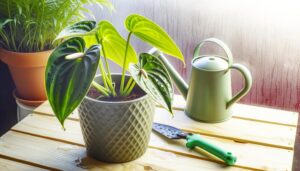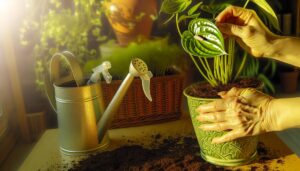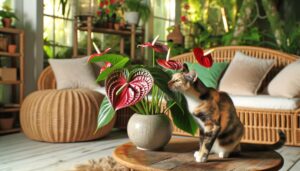Is Anthurium an Indoor Plant? Yes!
Yes, Anthurium can thrive indoors with proper care. These tropical plants from the Araceae family need temperatures between 65-80°F, bright indirect light, and well-draining soil to flourish.
Monitor water levels, ensuring the top inch of soil dries out before rewatering to prevent root rot. Maintain humidity between 60% and 80% using a humidifier or pebble tray.
Regularly check for pests and maintain air circulation to avoid fungal diseases. Their vibrant spathes and lush foliage contribute to air purification, enhancing indoor air quality.
Implementing these conditions will support your Anthurium’s best growth and health, providing you more detailed guidelines ahead.
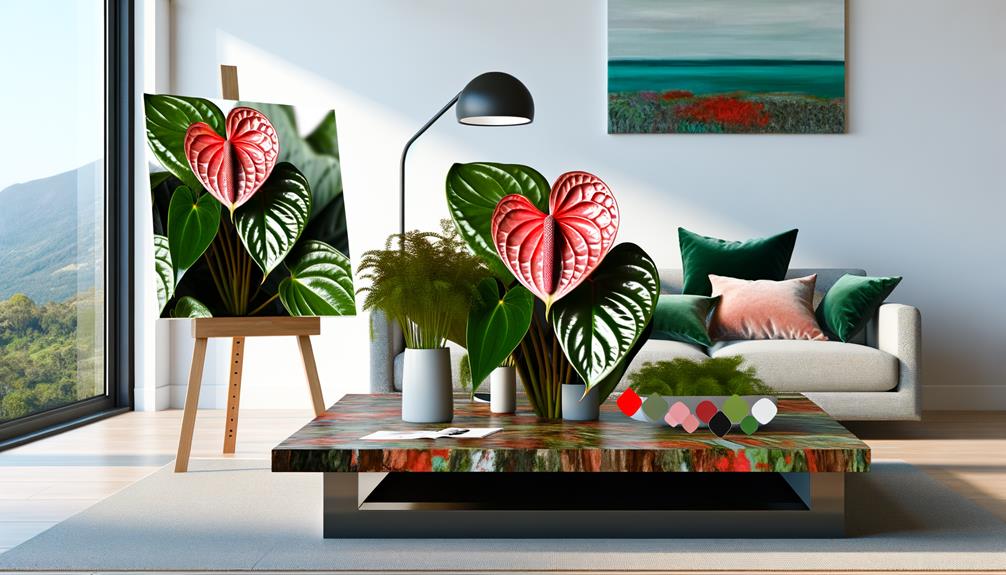
Key Takeaways
- Anthuriums thrive indoors with bright, indirect light and controlled humidity.
- Ideal indoor temperatures for Anthuriums range between 65-80°F.
- Anthuriums purify indoor air by absorbing VOCs and releasing oxygen.
- Proper indoor care includes well-draining soil, regular watering, and pest monitoring.
- Indoor Anthuriums offer decorative appeal with vibrant flowers and lush foliage.
Understanding Anthurium Basics
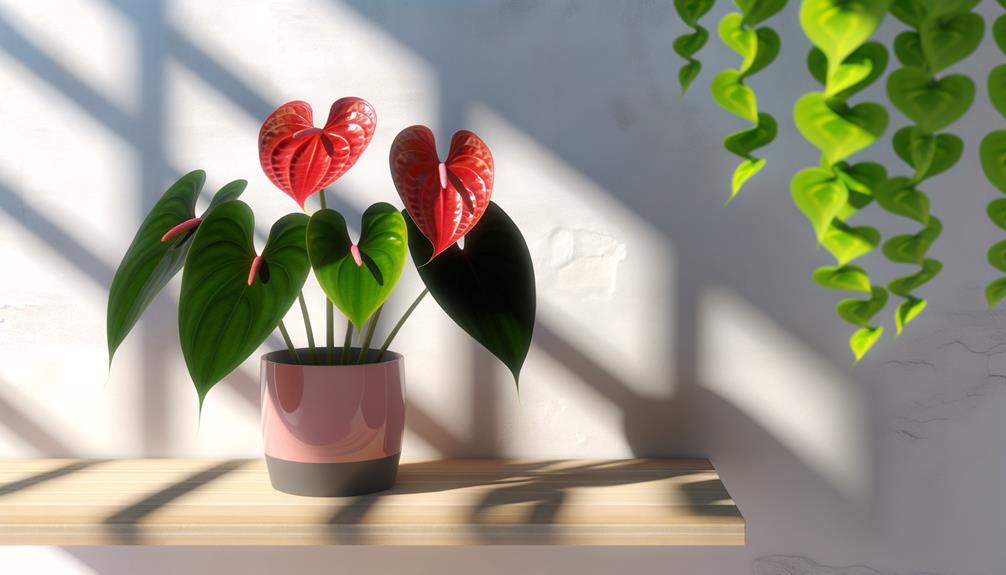
Anthurium, a genus within the Araceae family, encompasses over 1,000 species known for their striking spathes and vibrant foliage. To propagate Anthurium, you can use methods like seed germination, stem cuttings, or division.
Each method impacts the growth patterns, influencing factors like root development and leaf emergence.
Flower colors range from deep reds to bright whites, attributed to the spathe’s pigmentation and spadix variations.
Understanding their growth patterns is essential; Anthuriums typically exhibit slow to moderate growth. They prefer temperatures between 65-80°F (18-27°C), thriving in warm, humid conditions.
Sudden temperature fluctuations can stress the plant, affecting both foliage and bloom quality. Optimal temperature management ensures robust growth and vibrant, long-lasting flowers.
Ideal Indoor Conditions
To guarantee strong growth and lively blooms, maintaining ideal indoor conditions is essential for Anthurium cultivation.
You should focus on several key factors:
- Temperature Control: Keep the ambient temperature between 65-80°F. Avoid sudden fluctuations as they can stress the plant.
- Air Circulation: Ensure good airflow to prevent fungal diseases. Use a small fan if necessary.
- Proper Drainage: Select a well-draining potting mix to prevent root rot. Incorporate perlite or orchid bark for best results.
- Pot Size: Choose a pot that allows for gradual growth. A pot that’s too large can lead to water retention issues, while too small can restrict root expansion.
Light Requirements
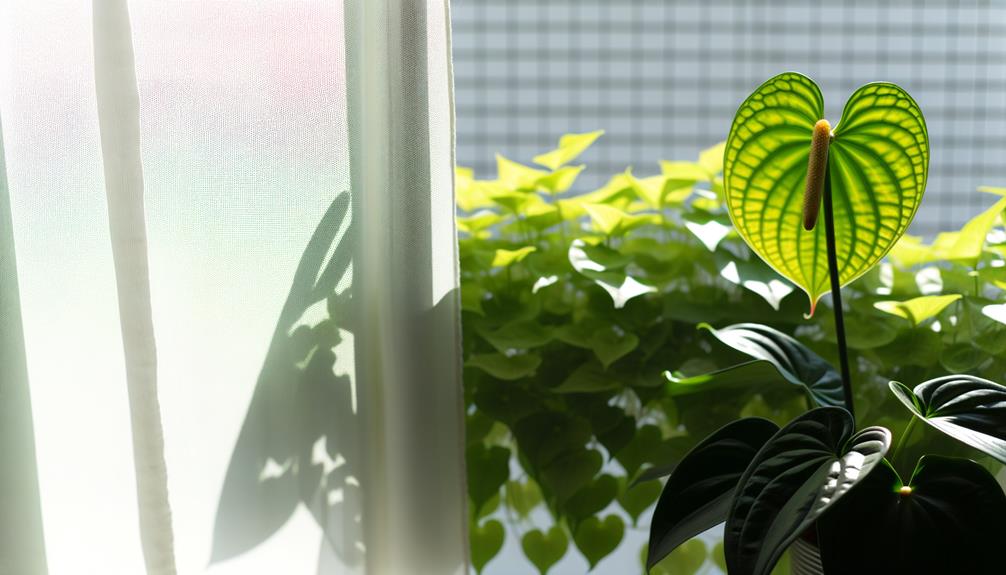
Perfect light exposure significantly impacts Anthurium’s photosynthetic efficiency and overall health. You should provide bright, indirect light to replicate their natural tropical habitat.
Direct light can scorch the leaves, leading to photodamage and chlorosis. Natural light filtered through sheer curtains or positioned in east or north-facing windows offers optimal conditions.
If natural light is insufficient, artificial light sources such as fluorescent or LED grow lights can be utilized. Ensure these lights emit a full spectrum to support photosynthesis. Position the artificial light 12-18 inches above the plant, providing 12-14 hours of light daily.
Monitoring light intensity and duration is crucial; excessive or insufficient light can hinder growth and impair Anthurium’s physiological functions.
Watering Guidelines
Consistently maintaining appropriate soil moisture is vital for Anthurium’s health, as these plants flourish in a balance between hydration and aeration.
To achieve this, you should focus on several critical factors:
- Watering frequency: Water your Anthurium when the top inch of soil feels dry. Overwatering risks damaging the plant by suffocating roots.
- Proper drainage: Utilize pots with drainage holes to ensure excess water exits, preventing waterlogged conditions.
- Root rot prevention: Ensure soil is well-draining to avoid stagnant water, which can lead to root rot.
- Hydration balance: Monitor soil moisture regularly using a moisture meter to maintain the best possible hydration without oversaturating.
Humidity Needs

Maintaining ideal moisture is equally important for Anthurium’s health, as these tropical plants thrive in environments with relative moisture levels between 60% and 80%.
Low moisture can cause browning of leaf edges, a clear indicator of stress. To achieve optimal moisture levels, employ a humidifier or place the plant on a pebble tray filled with water.
Frequent misting can also aid in moisture control, but guarantee the leaves dry quickly to prevent fungal infections.
Monitoring moisture levels with a hygrometer is vital for accurate care tips. By maintaining appropriate moisture, you’ll promote robust plant health, leading to vibrant foliage and prolific flowering.
Consistent moisture control mitigates common issues like leaf drop and ensures sustained Anthurium strength.
Soil and Potting Mix
A well-draining, aerated potting mix rich in organic matter is vital for Anthurium’s best root development and nutrient absorption. You should aim to create a mix that balances moisture levels while preventing waterlogging.
Make sure your pot has sufficient drainage holes to facilitate this balance. Regularly monitor and adjust the repotting frequency and pot size to accommodate growth.
Consider the following components for an excellent potting mix:
- Pine Bark: Enhances aeration and structure stability.
- Coconut Coir: Retains moisture while providing good drainage.
- Perlite: Improves soil porosity and prevents compaction.
- Activated Charcoal: Helps in absorbing toxins and excess moisture.
These elements together create an ideal environment for your Anthurium’s health and growth.
Fertilization Tips
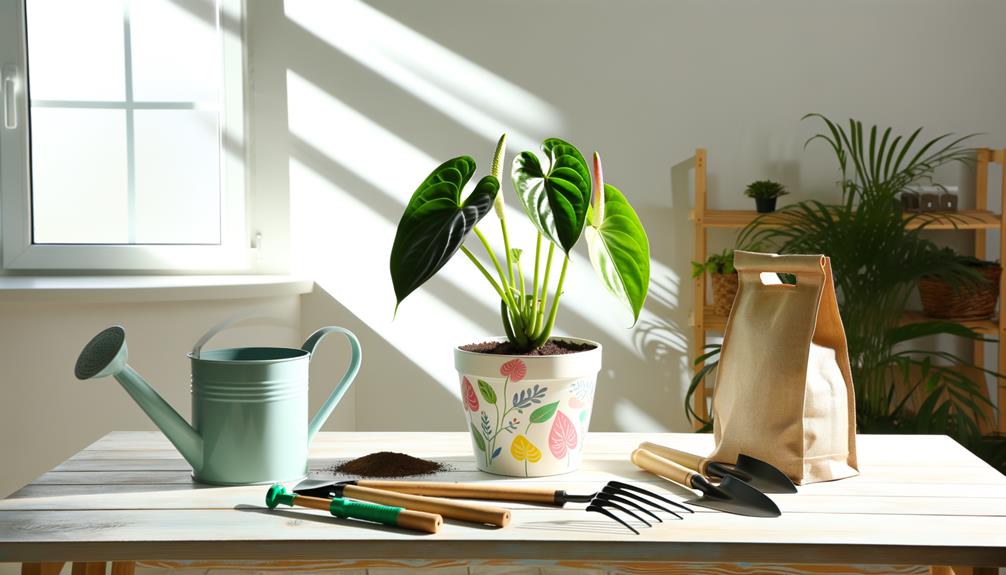
You should stick to a bi-monthly fertilization schedule, using a balanced, water-soluble fertilizer with an N-P-K ratio of 20-20-20.
Guarantee the nutrient solution is diluted to half strength to prevent root burn and nutrient toxicity.
Monitor for signs of nutrient deficiencies, such as chlorosis or stunted growth, to adjust the feeding regimen accordingly.
Optimal Feeding Schedule
To safeguard Anthurium thrives, implement a fertilization regimen that includes a balanced, water-soluble fertilizer applied bi-monthly during the growing season.
This feeding frequency promotes optimal growth and helps prevent potential nutrient deficiency, thereby enhancing plant health.
Here are key aspects to take into account:
- Dilution Ratio: Use a fertilizer with a 20-20-20 N-P-K ratio at half strength to avoid root burn.
- Application Timeframe: Focus on the growing season, typically from spring to early fall, as this is when nutrient uptake is at its peak.
- Soil Moisture: Ensure the soil is evenly moist before application to aid in nutrient absorption.
- Observation: Regularly monitor leaf color and growth patterns to identify signs of nutrient deficiency or over-fertilization promptly.
Following this schedule promotes robust Anthurium health.
Nutrient Requirements
Wondering how to make sure your Anthurium gets the right nutrients for best growth? Understanding its nutrient requirements is important. Anthuriums thrive with balanced fertilization that supports their growth patterns.
Use a high-phosphorus fertilizer to promote blooming. Apply a liquid fertilizer diluted to half strength every 6-8 weeks during the growing season.
Regular monitoring of watering frequency is essential to prevent nutrient leaching. Make sure the soil remains moist but not waterlogged. Here’s a quick guide:
| Fertilizer Component | Purpose |
|---|---|
| Nitrogen (N) | Promotes leaf and stem growth |
| Phosphorus (P) | Enhances root development |
| Potassium (K) | Improves overall resilience |
| Micronutrients | Supports metabolic functions |
Common Pests and Diseases
You’ll often encounter common insect infestations like aphids and spider mites, which can severely damage Anthurium foliage. Fungal diseases such as root rot manifest through symptoms like yellowing leaves and stunted growth.
Effective prevention and treatment strategies include maintaining best humidity levels and applying fungicides or insecticidal soaps as needed.
Common Insect Infestations
Anthurium plants are susceptible to a variety of common insect infestations, including aphids, mealybugs, and spider mites, which can compromise their health and growth. Implementing rigorous pest control methods is necessary to maintaining plant resilience.
Consider these insect infestation prevention techniques:
- Regular Inspection: Frequently check your Anthurium for early signs of pests to facilitate prompt intervention.
- Natural Remedies: Utilize neem oil or insecticidal soap to mitigate pest populations without harming the plant.
- Optimal Humidity: Maintain high humidity levels, as spider mites thrive in dry conditions.
- Quarantine New Plants: Isolate new additions to your indoor garden to prevent the introduction of infestations.
Fungal Disease Symptoms
Fungal diseases in Anthurium plants often manifest as leaf spots, root rot, or blight, requiring careful monitoring and timely intervention to prevent irreversible damage.
Early detection and treatment are essential to maintaining plant health. Leaf spots, caused by fungi like Colletotrichum, appear as dark, water-soaked lesions.
Root rot, typically induced by Phytophthora, results in blackened, mushy roots. Blight, often due to Botrytis, leads to wilting and gray mold on leaves.
| Symptom | Causal Agent |
|---|---|
| Leaf Spots | Colletotrichum |
| Root Rot | Phytophthora |
| Blight | Botrytis |
Prevention and management strategies include maintaining proper sanitation, avoiding overwatering, and ensuring adequate air circulation. Recognizing these symptoms early and taking prompt action can mitigate severe damage.
Prevention and Treatment Strategies
To effectively safeguard against common pests and diseases in Anthurium plants, implementing rigorous prevention and treatment strategies is crucial.
You should focus on plant health through a holistic approach and consider organic solutions for pest control.
Here are four essential strategies:
- Regular Monitoring: Inspect plants weekly for signs of pests like aphids or spider mites.
- Proper Sanitation: Remove dead leaves and debris to reduce fungal and bacterial growth.
- Organic Solutions: Use neem oil or insecticidal soap to manage pest infestations without harmful chemicals.
- Optimal Environment: Maintain humidity levels around 60-80% and guarantee sufficient airflow to prevent mold and mildew.
Pruning and Maintenance
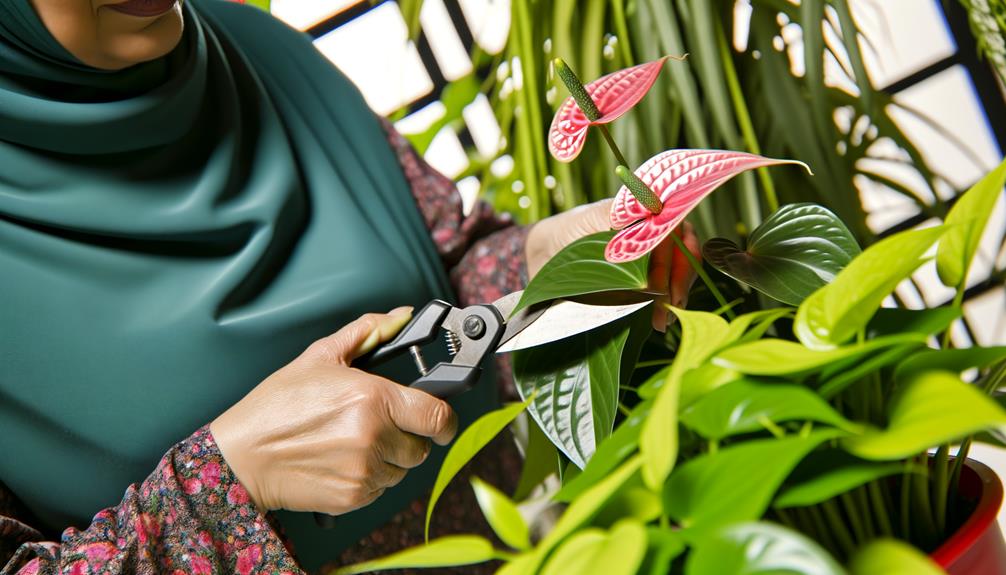
Regularly, you should utilize sterilized pruning shears to remove any dead or yellowing leaves, maintaining the Anthurium’s peak health and growth.
Employing precise pruning techniques, you can influence the plant’s growth patterns, promoting a fuller, healthier appearance.
Establishing a maintenance schedule is crucial to monitor leaf health and overall plant essentiality.
To assist you, here’s a concise table outlining necessary pruning and maintenance tasks:
| Task | Frequency |
|---|---|
| Prune dead leaves | Weekly |
| Inspect for pests | Bi-weekly |
| Fertilize | Monthly |
| Clean foliage | Bi-weekly |
| Check soil moisture | Weekly |
Adhering to these practices will guarantee your Anthurium thrives indoors, displaying robust growth and vibrant foliage.
Benefits of Indoor Anthuriums
Indoor Anthuriums offer significant benefits, including air purification, aesthetic enhancement, and psychological well-being, making them a valuable addition to any indoor environment.
Integrating these plants into your living space can enhance your quality of life through various mechanisms:
- Air Purification: Anthuriums absorb volatile organic compounds (VOCs) and release oxygen, improving indoor air quality.
- Health Benefits: By reducing airborne toxins, Anthuriums contribute to respiratory health and overall well-being.
- Decorative Appeal: Their vibrant spathes and lush foliage provide a visually appealing element, enhancing any interior decor.
- Stress Reduction: Interaction with Anthuriums can lower cortisol levels, promoting relaxation and mental tranquility.
Incorporating Anthuriums into your indoor space can yield both health benefits and decorative appeal, making them an excellent choice for enhancing living environments.
Conclusion
To sum up, nurturing an anthurium as an indoor plant isn’t rocket science, but it does require some attention to detail. By ensuring ideal light, humidity, and watering conditions, you’ll find your anthurium thriving rather than just surviving.
Regular pruning and vigilant pest management will keep your plant in top shape. So, embrace these guidelines, and you’ll transform your living space into a verdant sanctuary with a touch of botanical elegance.

